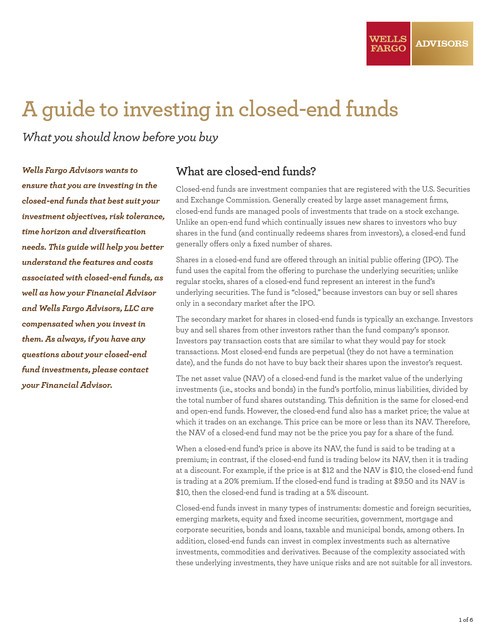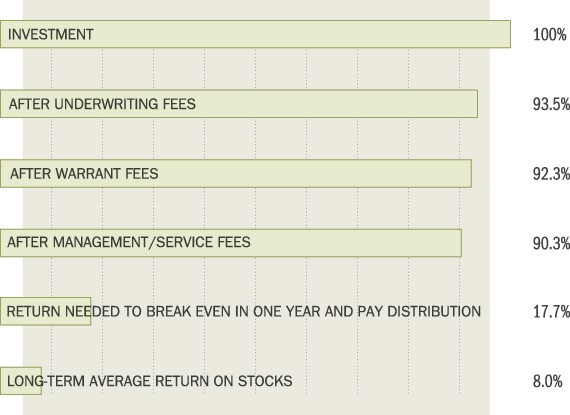An Investing Guide to ClosedEnd Funds
Post on: 27 Июнь, 2015 No Comment

Despite the name, closed-end funds behave more like individual stocks
JewishWorldReview.com | (USNWR) Closed-end funds (CEFs) may be one of the most misunderstood investments.
CEFs are called funds, but they really behave more like individual stocks. Unlike individual equities, they may involve a bit more math to determine an attractive entry point. There’s a benefit in the difficulty, perhaps. Curious investors are forced to do their homework. And considering the volatility of certain CEFs, a little extra studying is a good thing.
For the mostly higher-net-worth, higher-risk-profile investors that are the target audience for closed-end funds, these investments provide potential reach that tops other funds. Because a closed-end fund does not need to maintain cash reserves or sell securities to meet redemptions, the fund manager has the flexibility to invest in less-liquid securities. A CEF may invest in securities of very small companies, thinly traded municipal bonds, or securities originating in countries that can’t be accessed by traditional means because they don’t yet have fully developed public markets.
Of course, added volatility can come with that flexibility. Unlike regular stocks, closed-end fund holdings often represent an interest in a specialized portfolio of securities that is actively managed and typically concentrated in a specific industry, geographic market, or sector. The cost of the transaction for a CEF is similar to the cost of a stock trade. There are also internal management fees paid to the fund company.
Decade of growth. An estimated 2.1 million U.S. households owned closed-end funds in 2010, according to the Investment Company Institute. These households included mostly retired, higher-income, experienced investors that owned a range of equity and fixed-income investments.
FREE SUBSCRIPTION TO INFLUENTIAL NEWSLETTER
Bonds account for more than half of all closed-end fund assets, according to ICI. However, assets in equity closed-end funds grew from 26 percent a decade ago to 42 percent of all closed-end fund assets at the end of 2010, the latest data available.
There are some key differences between traditional mutual funds and closed-end funds. Like a single stock, CEF market value is driven by supply and demand for the shares. A manager invests a fixed amount of cash during the initial public offering of the fund’s shares. Closed-end funds also may make subsequent public offerings of shares in order to raise additional capital. Investors buy the shares from other investors via a stock exchange, or sometimes in over-the-counter transactions. An open-end mutual fund, on the other hand, continually issues new shares to investors. Cash flows in and out of mutual funds.
There’s an important calculation that can help investors separate net asset value (NAV) from a closed-end fund’s price, two figures that are often confused. To figure NAV, add the combined value of the CEF’s holdings (including stocks, bonds, cash, etc.), subtract liabilities, and divide by the total number of shares held by investors.
CEFs are often bought or sold at a discount to their NAV, and in the difference between price and NAV is the potential opportunity for investors. Investors are targeting CEFs with strong prospects trading at an attractive discount. They’re wagering that the gap between the discount and the underlying asset value will close after they buy the fund. Conversely, shares are said to trade at a premium when the share price is higher than the NAV.
For example: If a CEF owns 100 stocks that have a combined value of $1 million with $0 liabilities and 100,000 shares outstanding, the fund has an NAV of $10. Investors might not value the portfolio manager’s ability to pick stocks, however, so they might only be willing to pay $9 per share of the fund. So, this fund would be trading at a discount of 10 percent to its NAV.
This isn’t to say you should never invest at a premium. Most CEF investors have no qualms investing at slight premiums to NAV. But absolute premiums above 10% should really give you pause, say Morningstar analysts. Morningstar uses the term absolute when discussing the share price/NAV relationship; it does so to distinguish from when it is referring to historical discounts and premiums.

Income source. Keep in mind that the primary benefit of purchasing a closed-end fund at an absolute discount is for income-seeking investors to enhance their yield, Morningstar research also states. Morningstar advises against purchasing CEFs at absolute discounts in hopes that the share price will converge to a higher NAV, rather than primarily for the income. See more on the yield calculation at Morningstar .
For income-seeking investors, instead of viewing discounts as a way to purchase $1.00 of assets for, let’s say, $0.70, income seekers should think of buying $1.00 of ‘earning assets’ for $0.70. After all, if a fund is earning 5% on every $1.00 it invests, those of us purchasing these assets for $0.70 are actually earning 7.1% on our investment, says Mike Taggart, director of closed-end fund research at Morningstar, in a commentary.
This is referred to as yield enhancement and is, perhaps, the most compelling reason to invest in CEFs for the long term, he writes. Regardless of subsequent swings in share price, as long as the fund continues to earn 5% and maintains its distribution rate, a buy-and-hold investor under this scenario will continue to earn 7.1%.
Sign up for the daily JWR update. It’s free. Just click here.
Interested in a private Judaic studies instructor — for free? Let us know by clicking here.
Comment by clicking here .














